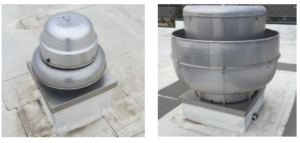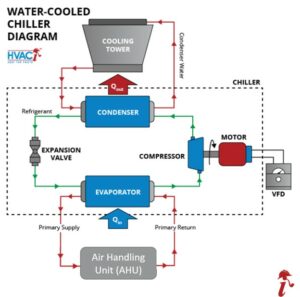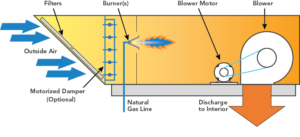Less Common Commercial HVAC Systems Adjusters Should Be Familiar With
Most commercial policyholders use package units and split systems; however, other types of HVAC systems are prevalent in claims. Among them are exhaust fans, chillers, and make-up air units. It’s important adjusters know a little about each type of HVAC system – even less common ones – to ensure the most accurate settlement decisions.
Exhaust Fans
According to the CCG IQ 2020 Annual Report, exhaust fans were the third most frequently claimed system type. They are found in commercial kitchens, offices, manufacturing, and warehouse buildings and are used to remove stale air, cooking odors, and excessive moisture or heat. Among their advantages are ventilating a space to provide fresh air, improving air quality for a healthier atmosphere indoors, and removing moisture to prevent mold growth.
Exhaust fans operate by a motor turning either fan blades or a blower wheel, depending on the type, to pull contaminated air out of the building. Belt driven units rely on a belt to connect the fan or blower to the motor. In a direct drive unit, the motor is connected to the fan blades or blower wheel by a shaft or axle, and the blades rotate with the motor.

Policyholders may use an upblast or downblast exhaust fan, depending on their needs. Upblast exhaust fans are ideal for spaces with commercial kitchens, including restaurants or hotels. Air is blown out of the top, and, more importantly, a sealed compartment protects the motor from the heat, moisture, and contaminants being removed. Additionally, a secondary grease trap captures condensed grease to prevent it from getting onto the roof.
In contrast, downblast exhaust fans should never be used for kitchens or in places where contaminated air has grease. Downblast fans eject the air down toward the fan base and roof, which protects the motor from precipitation but could be a fire hazard if grease accumulated there. Downblast exhaust fans should be used to remove heat, stale air, and odors.
Among the predominant causes of loss are hail, wind, and smoke and fire; however, almost a third of the exhaust fan systems were in proper working condition at the time of assessment.
Chillers
Chillers are commonly used in airports, hospitals, hotels, shopping malls, restaurants, temporary structures, and industrial or medical facilities. They transfer heat out of a space using water or a water solution instead of air. Policyholders may have water-cooled or air-cooled chillers; however, the initial process is the same.
Warm water enters the evaporator unit from the primary return coming from the building’s Air Handler Units (AHUs) and its heat is transferred to the refrigerant. The now cooler water is then pumped by a water pump through the primary supply back to the AHU. A blower and the ductwork bring in air from the facility, and the water absorbs its heat. The now cooler air is supplied back to the conditioned space through the ductwork. This process is similar to that of a traditional HVAC split system or package unit. The warmer water then returns to the evaporator to restart the process.

The difference between air-cooled and water-cooled chillers is how the refrigerant transfers out the heat it absorbed from the water. Refrigerant moves from the evaporator to the compressor, which increases the refrigerant’s pressure and temperature, and then it goes to the condenser. In water-cooled chillers, water surrounds the refrigerant pipes to absorb the heat and then is pumped into a cooling tower to release the heat. Meanwhile refrigerant goes through the expansion valve to reduce its pressure and temperature and restart the process. In air-cooled chillers, fans bring outside air through the condenser, which absorbs heat from the refrigerant, and expels it to the ambient air – much the same as the process for traditional split systems and package units.
Despite the complex processes, chillers may be preferred over traditional split systems and package units because water conducts heat 25 times better than air. Each chiller type also has advantages. Water-cooled chillers are better at conducting heat, are more consistent, and are best for medium to large facilities, though they require a stable water supply and a lot more maintenance. Air-cooled chillers, which are better for small to medium facilities, have lower installation costs, less maintenance, and require less space.
Among the perils affecting chillers are corrosion and poor maintenance, which are linked with wear and tear, as well as electrical problems caused by wear and tear or high voltage surges.
Make-Up Air Units
Make-up air units aren’t claimed as often; however, when they are, make-up air units are frequently determined to be non-damaged, making damage assessment essential. As the name implies, make-up air units compensate for air that was removed through process exhaust fans or other mechanical means. While exhaust fans draw air out of a facility to the outside, make-up air units reclaim fresh air from outside to bring it into the building. However, unlike ventilation fans that bring in outside air without changing its temperature, make-up air units can temper air so the heating or cooling system won’t have to work harder or waste energy.

Make-up air units are typically used in industrial or other similar commercial applications, such as restaurants, warehouses, or distribution centers. These are areas where more ventilation is required to improve air quality and protect health. If too much air has been exhausted by mechanical means and isn’t replaced, the space can become depressurized. Having a make-up air unit deliver fresh air can restore the pressure and balance and contribute to the overall Indoor Air Quality, which may be part of a local, state, or federal regulation.
Types of make-up air units include direct gas-fired, indirect gas-fired, and non-gas fired. Direct fired units heat outdoor air directly through combustion of natural gas by an air burner. Indirect gas-fired make-up air units have combustion products discharged through a flue rather than within the supplied air. Non-gas fired options use electric, hot water, or steam heat as an alternative to gas.
Predominant causes of loss for make-up air units are hail, wind, and high voltage surge. Make-up air units are most frequently included on hail claims if they are on the roof. But since they don’t have any coils and have strong metal cases, they typically aren’t damaged by hail. Adjusters should make sure they aren’t settling for non-damaged equipment.
Consider Expert Assessment Before Settling a Claim
Due to the complexity of commercial HVAC systems, carriers can benefit from expert evaluations. HVACi is the nation’s leading provider of HVAC and Refrigeration damage assessment services for insurance carriers. Our team uses its HVAC system knowledge and experience to enable adjusters and insurance personnel to confidently settle claims based on data-driven testing, actionable reports, and prompt cycle times.
Dealing with a claim that has an HVAC system you aren’t familiar with? Submit a claim to receive cause of loss, scope of damage, and repair and replacement recommendations to return your policyholder’s system to pre-loss condition quickly and fairly.

